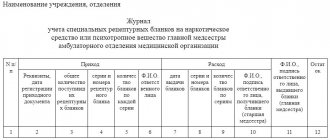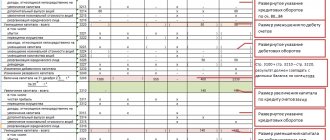Bookmarked: 0
Accounting statements are documents that any enterprise must regularly submit to the tax service in order to have an idea of the state of the enterprise at the present time (property, economic). There are a number of points in such reports for which they must be provided. In general, financial statements include a list of documents consisting of more than one hundred items. Reporting concerns:
- enterprise income (these are cash receipts from successful sales of goods, services, return of funds from loans, receipt of funds from shareholders);
- expenses of the enterprise (payment of taxes by the enterprise, payment of loans, purchase of raw materials or equipment).
After drawing up the final liquidation balance sheet
After the final liquidation balance sheet has been compiled, it must be approved by the persons who made the decision on liquidation. To do this, they need to draw up a protocol (decision) on approval or put the appropriate marks directly on the balance sheet.
Together with the final balance sheet, the liquidation commission places at the disposal of the founders (participants) all the property remaining after settlements with creditors. These assets must be distributed among the founders (participants) in accordance with their shares in the authorized capital.
Once all calculations have been made, the final package of documents for liquidation must be submitted to the tax office:
- application in form P16001 (notarized);
- final liquidation balance sheet;
- protocol (decision) on approval of the final liquidation balance sheet;
- a receipt for payment of state duty in the amount of 800 rubles.
- certificates from funds confirming the absence of debt (they are not required to be submitted, since the tax office must independently request this data from the Pension Fund and the Social Insurance Fund).
Form (form) and procedure for drawing up the liquidation balance sheet
Preliminary preparation of data and the preparation of the liquidation balance sheet itself, due to its certain specifics, usually falls on the shoulders of accounting workers. Although, formally, according to the law, this procedure must be carried out by the liquidation commission.
For 2021, there is no established form of the final liquidation balance sheet for commercial organizations (except for banks and budgetary institutions).
At the same time, in October 2021, the tax office officially explained that the liquidation balance sheet can be prepared in the form of a balance sheet, approved by the founders (participants) of the LLC or the person who made the decision to liquidate it.
Form No. 1 “Balance Sheet” recommended in such cases is usually taken as a basis.
.
You can download the developed form for the final liquidation balance sheet for free using this link.
What is LLC liquidation
Liquidation is a procedure for closing a legal entity, in which an entry is made in the Unified State Register of Legal Entities that the LLC is ceasing to operate and is being liquidated. After the procedure is completed, the legal successors do not receive the company's assets and liabilities.
Liquidation is possible in two options - voluntary and forced. Compulsory is usually carried out by a court decision made at the initiative of one of the founders, tax or other government agency. It may be associated with violation of the law, registration errors, or bankruptcy. Also, the tax office can forcibly exclude an LLC from the Unified State Register of Legal Entities without a trial if the register contains false information or the company in fact does not conduct business.
The founders of the LLC carry out the voluntary process according to their decision - we will talk about this type of procedure in more detail.
To liquidate an LLC voluntarily, you need to:
- Hold a general meeting of founders and make a decision on liquidation.
- Appoint those responsible for the procedure - a liquidator or a commission.
- Report to Federal Resources, tax authorities and creditors.
- Prepare liquidation balance sheets.
- Submit information to the Pension Fund.
- Pay off the debts of the LLC.
- Distribute the remaining property among the LLC participants.
- Register the liquidation with the Federal Tax Service.
But in the process of fulfilling these points, the LLC should not forget about its standard responsibilities - pay salaries and taxes, pay off debts to counterparties, and also submit reports. Read more about reporting below.
The main purpose
Each fixed report has its own individual method; keeping it all in your head at the same time is almost impossible unless you have been working in this field for twenty years, and remembering all the meanings is just as difficult, which is why a large number of specialists are confused about this concept, for example, “ Is the twenty-first moment quarterly or monthly?”
Everything depends directly on the declaration; codes can have different meanings, which sometimes confuses an accountant.
There are ciphers that are created to identify types of declarations; the codification features have a large number of features. In order to designate a certain period of time or a specified period, a form has been drawn up that defines fiscal reporting. The cipher represents a two-digit number, for example, periods twenty-two, fifty, thirty-one, and so on.
Each type of tax reporting provides for an individual codification procedure. Therefore, each company uses its own version of calculation for the correct final work. Ciphers for reports are determined by the main types; they are intended for full-fledged work in order to eliminate time wasted on unnecessary things.
Should I submit reports upon liquidation of an LLC in 2020?
All reports that the organization submitted while it was operating must continue to be submitted. While the process is underway, do everything in the standard order. But reporting for the last period in which the company operated is submitted within special deadlines and with changes in the filling procedure.
During the liquidation procedure of an LLC, it is necessary to submit reports to several regulatory authorities - the Federal Tax Service, the Social Insurance Fund and the Pension Fund of the Russian Federation. They will be waiting for accounting, as well as tax and employee reports.
Here is a complete list of reports that must be submitted:
- Declaration of profit, simplified tax system, UTII or unified agricultural tax.
- 6-NDFL and 2-NDFL.
- Declarations and calculations for other taxes and fees: property tax, mineral extraction tax, water tax, VAT, etc.
- RSV.
- Calculation of 4-FSS.
- Personal reporting for employees: SZV-M, SZV-STAZH, SZV-TD, DSV-3, information information.
- Liquidation balances.
- Reporting to Rosstat.
Fines for late submission of reports will not bypass liquidating legal entities. For example, for tax returns and the DAM, the amount of the fine will be 5% of the unpaid tax for each month of delay, but not less than 1,000 rubles and not more than 30%. Any fines received during the liquidation process will be added to the LLC's liabilities, which must be paid off before closure.
Next, we will analyze the procedure for preparing all reports and the rules for submitting liquidation reports in 2021 and 2021.
What are the intervals for accounting?
First of all, it is necessary to mention those documents that make up the financial statements of absolutely any period.
Usually this is: a balance sheet and a statement of financial results of the enterprise. The balance sheet is a statement of the assets and liabilities of a business. In this case, assets are understood as all the property of the enterprise: from real estate and products to the most ordinary ballpoint pen, and liabilities are capital and reserves, as well as liabilities (all funds that the enterprise received for development and stable operation and is now obliged to return within the established time frame) . This could be shareholders’ money, loans from credit institutions, and other funds.
The financial results report contains the most complete and reliable data on all purchases, sales, expenses for raw materials and equipment, taxes paid and tax benefits, in short, about the smallest penny that has ever been received or given by any employee of the enterprise as part of the work process .
As mentioned above, financial statements represent a very powerful layer of information about the activities of an enterprise. An intelligent manager who regularly studies financial documentation for reporting periods and compares information will be able to foresee ways of business development, assess the profitability or, conversely, unprofitability of certain areas of production, detect increased losses where this should not be, and a thousand other little things.
That is, accounting reporting is one of the effective tools for making far-sighted management decisions. In addition, reports must be submitted to the tax service to assess the activities of the enterprise and monitor the correct payment of all taxes due.
The report, which, as we remember, includes a balance sheet and information about profits and losses (as well as, if necessary, an auditor’s report, appendices to the balance sheet and other necessary financial statements), is submitted to the tax service before March thirty-first of the current year. That is, the financial report for 2021 must be submitted by March 31, 2021.
The reporting period for financial statements can also be a month, a quarter or a half year. Reporting for these periods is called intra-annual or interim.
Until recently, enterprises were required, in addition to annual financial statements, to also submit interim ones, but this requirement is no longer in effect (according to letter of the Russian Ministry of Finance dated October 23, 2012 No. 03-11-09/80).
However, some organizations, such as insurance companies, are still required to file interim (quarterly) reports with the tax authorities. Those for whom interim reporting is not mandatory are still not recommended to neglect it, because it is known: the more often the results are summed up, the more accurately the records are kept. In addition, by comparing the final figures, it is easier to identify an error or deficiency.
| Type | date | Required electronic reporting |
| 4-FSS for the past year | Annual report - paper version - until January 20, electronic - until January 25 | Over 25 workers |
| 4-FSS for the current year 2021 | Quarterly - April 20, July 20 and October 20 (for paper format), for electronic - April 27, July 27 and October 27 | More than 25 |
| RSV-1 for the past year | Year – February 15 (for paper version), for electronic – February 22 | More than 25 workers |
| RSV-1 for 2021 | Every 3 months – May 16, August 15, November 15 (paper format), Electronic – May 20, August 22, November 21 | From 25 employees |
| Type | date | Required electronic reporting |
| VAT declaration | Quarterly – January 25, April 25, July 25, October 25 | Any number of workers |
| Average number for 2021 | Once a year - January 20 | Over 100 employees |
| For transport and land taxes | Once a year – February 1 | From 100 employees |
| Declaration on the use of the simplified tax system | Once a year. For enterprises – March 31, for businessmen – May 3 | More than 100 people |
| According to UTII | Every quarter – January 20, April 20, July 20, October 20 | Over 100 |
| Personal income tax | Every quarter – May 3, August 1, October 31 | More than 25 employees |
| Type | Deadlines |
| UTII | Quarterly until the 20th |
| Under the simplified tax system for the tax service, in extra-budgetary funds, in statistics | No need to submit until April 30th, no need either |
Reporting period
For the preparation of financial statements, the reporting date is considered to be the period between January 1 and the date on which the report is prepared. The main reporting period is a year, the intermediate one is a quarter.
There is such a thing as “accounting reporting period code” - a two-digit number that is given a separate place in the report.
| 1st-12th | Reporting period code, which is equal to a month |
| 20 | Quarterly code |
| 21-22 | Code from 1st to 4th quarters |
| 31 | For half a year |
| 33 | In 9 months |
| 34 | Annual code |
| 90 | Reorganized enterprise |
| 94 | Reformed |
Coding is necessary for quick reference in reporting information.
Annual reports
Compiled at the end of the reporting year. How to properly prepare annual reports? First, the accountant must check whether the transactions carried out in the organization are correctly reflected.
Annual reports are submitted 3 months from the beginning of the new year. If the last reporting date falls on a weekend, it is postponed until the next working day.
Compilation requirements:
- information must be neutral, that is, exclude the satisfaction of requests of one category over others;
- it is necessary to indicate the indicators of all divisions of the organization;
- facts and performance results for the year must be reliable;
- sequencing.
The annual declaration is submitted by all individuals and legal entities. It is not provided if the taxpayer received the following income:
- from agents who have already withheld tax at the time of payment;
- from one tax agent;
- in case of sale or exchange of property when the tax has already been paid;
- in case of receiving an inheritance;
- if the amount of taxes for the year does not exceed 120 times the minimum wage.
Entrepreneurs submit an annual declaration, even if there was no activity for a certain period.
https://www.youtube.com/watch?v=
Individuals submit a report before May 1 of the year following the reporting year, entrepreneurs - before February 9.
Registration procedure:
- Carrying out an inventory approved by the commission.
- Reconciliation of mutual settlements with creditors, budget, and other enterprises.
- Registration of postings.
- Closing those accounts that play a minor role in collecting data for the report.
- Entering information into the declaration.
- Reporting.
Since the reporting is annual, the listed items should be as close as possible to the reporting date. If the organization has recently opened, then reporting is completed from the moment of registration.
Order of the Federal Tax Service of Russia dated October 29, 2014 N ММВ-7-3/
Income tax
Order of the Federal Tax Service of Russia dated November 26, 2014 N ММВ-7-3/
during reorganization (liquidation) of an organization
Calculation of advance payments for property tax
Order of the Federal Tax Service of Russia dated November 24, 2011 N ММВ-7-11/895
Property tax declaration
Order of the Federal Tax Service of Russia dated November 24, 2011 N ММВ-7-11/895
Order of the Federal Tax Service of Russia dated February 20, 2012 N ММВ-7-11/
Declaration of tax paid when applying the simplified tax system
Order of the Federal Tax Service of Russia dated July 4, 2014 N ММВ-7-3/
(upon termination of activity as an individual entrepreneur)
Order of the Federal Tax Service of Russia dated July 4, 2014 N ММВ-7-3/
Order of the Federal Tax Service of Russia dated October 14, 2015 N ММВ-7-11/
Unified calculation of insurance premiums
Order of the Federal Tax Service of Russia dated October 10, 2021 No. ММВ-7-11/
Tax returns must indicate the tax period code.
Digital designations of periods depend on the type of declaration. We’ll figure out what codes to use when reporting taxes in this article.
- month;
- quarter;
- half year;
- 9 months;
- year.
For consolidated groups of taxpayers, their own codes have been approved: from 13 to 16 (where code 14 corresponds to a half-year, and 16 to a year).
The coding of monthly reporting of consolidated groups begins with code 57 and ends with code 68.
When liquidating a company, you need to enter code 50.
51 - I quarter during reorganization;
47 - half a year during reorganization;
48 - 9 months during reorganization.
There are other codes corresponding to certain reporting periods.
Thus, when preparing reports for several months, digital designations are used in the number range from 35 to 46.
The form of submission depends on the number of employees - if there are many of them, then only the electronic version of reporting is used. New forms: 3-NDFL Provides for new tax rates on dividends In form 2-NDFL There have also been changes Starting in April, employers are required to submit a simplified report for each employee to the Pension Fund, indicating personal data, identification code and insurance code Another quarterly reporting has been introduced 6-NDFL If the report is not submitted on time A fine of one thousand rubles is provided for each overdue month If the report contains incorrect data Fine 500 rubles In 2021, the chief accountant has the right not to sign the report.
Order of the Ministry of Finance of the Russian Federation N 124n) Total current assets Value added tax on acquired assets Financial investments (except for cash equivalents) Filing reports in 2018 to the tax office - what are the deadlines and reporting periods? Advice: if annual financial statements are prepared by small enterprises, then, in accordance with the regulations of Federal legislation, they are allowed to submit simplified forms of the above reports to Rosstat and the Federal Tax Service.
- when submitting reports in paper form directly to the Federal Tax Service, the last day of submission of reports is considered to be the actual submission to the authorized inspector employee,
- when sending a paper version of financial statements by mail, the delivery date will be the day when the statements are submitted to the post office,
- the electronic version of the financial statements should be considered submitted from the date indicated in the automatically generated receipt for acceptance of the financial statements in electronic form.
- 21 - first quarter;
- 31 - 6 months (six months);
- 33 - 9 months;
- 34 - year;
- 50 is the last reporting period in the financial statements and tax reports during the reorganization (liquidation) of the institution.
When to cook
When declaring a liquidation procedure, an organization must compile a LP. First of all, an intermediate LB is formed, with the help of which the actual values are determined for the following key indicators:
- mutual settlements with counterparties;
- assets;
- liabilities;
- property value and so on.
Interim reporting is prepared after the publication of the notice of liquidation, 2 months after the release of the official Bulletin notifying creditors of the procedure being carried out. The PLB can be compiled repeatedly - based on indicators as of the reporting date or another date, so a copy of it does not have to be provided to the territorial tax office.
The final LB sums up the financial and economic activities of the organization. OLB is an accounting register that is compiled after the completion of all mutual settlements with counterparties (creditors, employees, government agencies) and reflects the economic condition of the institution at the time of its closure. The final liquidation balance is zero, as it is compiled at the stage of completion of the liquidation process. This document must be submitted to the Federal Tax Service once, on the date preceding the exclusion of the organization from the Unified State Register of Legal Entities. To reflect the opening balances in the OBL, the opening balances of interim reporting are used.
The formal type of reporting during liquidation is not fixed by any legal act, therefore both the final and interim LB are compiled according to Form No. 1 “Balance Sheet”.
The answer to the question, what is the liquidation balance code: 90 or 94, is as follows:
- 90 — LB code (final);
- 94 - PLB code.
What it is
The liquidation balance sheet is a balance sheet that is compiled during the liquidation of an LLC in order to determine the actual property state of affairs of the liquidated enterprise.
The liquidation balance can be intermediate and final
.
The final liquidation balance sheet is drawn up after repayment of all debts to counterparties, employees and the state (taxes, insurance premiums, etc.). It contains information about those assets of the company that remain and must be distributed among the founders and participants of the LLC.
note
, the amount of assets in the final balance sheet should not be greater than in the interim balance sheet, otherwise the tax office may request clarification and even refuse to liquidate the company. This is done in order to identify unscrupulous liquidators who temporarily withdraw their assets from the LLC in order not to pay debts to creditors.
Entrust reporting to specialists
Interim liquidation balance sheet
The PLB is drawn up after the commission has determined the composition of the LLC’s property and the deadline for presenting creditors’ claims has expired. There is no special form for the PLB; it is drawn up according to the standard or simplified form of the balance sheet, but with the appropriate note “Interim liquidation balance sheet” (Letter of the Federal Tax Service of Russia dated 08/07/2012 No. SA-4-7/13101). The recommended forms are given in the Letter of the Federal Tax Service of Russia dated November 25, 2019 No. VD-4-1/ [email protected]
The appendices to the PLB must disclose information about the organization’s property, creditors’ claims, the results of the consideration and the list of claims that were satisfied by a court decision.
The liquidation commission submits the PLB for approval to the founders of the LLC, and then sends a notification to the registration authority in the form P15016. There is no need to submit your balance sheet anywhere.
Submission of interim accounting reports
According to paragraph 5 of Art. 13 402-FZ, accounting records that are compiled for an interval of less than one calendar year are considered intermediate. These can be monthly or quarterly registers.
Interim reports are submitted only when the organization is obliged to submit them in accordance with the current legislation of the Russian Federation, by-laws and regulations, as well as constituent documents or decisions of managers and owners (clause 4 of Article 13 402-FZ). In such cases, the OP dates must be fixed in the accounting policies of the institution.
The deadline for submitting intermediate forms is not established by current legislation. The deadlines and time intervals for which you need to report are determined by internal and external users of accounting.
DIRECTORY OF CODES DETERMINING THE TAX (REPORTING) PERIOD
| Code | Tax (reporting) period |
| Section 1. Codes for documents prepared for the tax period - month | |
| 01 | January |
| 02 | February |
| 03 | March |
| 04 | April |
| 05 | May |
| 06 | June |
| 07 | July |
| 08 | August |
| 09 | September |
| 10 | October |
| 11 | november |
| 12 | December |
| Section 2. Codes for documents compiled for the tax period - quarter | |
| 21 | 1st quarter |
| 22 | 2nd quarter |
| 23 | 3rd quarter |
| 24 | 4th quarter |
| Section 3. Code for documents compiled only for the tax period - calendar year | |
| 34 | year |
| Section 4. Codes for documents compiled on an accrual basis from the beginning of the year: | |
| 4.1. |
How reporting is prepared
In addition to Federal Law No. 402, the principles for preparing financial documentation are listed in Accounting Regulations (PBU) 4/99. The rules for the formation of interim documentation are prescribed in PBU 23/2011.
Documents from organizations can be provided in forms approved by the legislation of the Russian Federation (in particular, Order of the Ministry of Finance No. 66n dated July 2, 2010) or stipulated by the organizational and legal form of the enterprise, its constituent documents or the decision of the owner.
The reporting period contains a specific coding
Requirements
Official documentation provided by a legal entity to state regulatory authorities must comply with the requirements set for it. They are listed in Federal Law No. 402, PBU 4/99, 23/2011 and orders of the Ministry of Finance No. 66n and 67n.
The information contained in the reports must meet the following criteria:
- completeness and reliability - information must fully describe the current financial condition of the legal entity, the economic results of its business activities and the movement of its assets, without concealment or exaggeration;
- neutrality – data in documents should be presented in a neutral form, without focusing on certain points;
- materiality – data on individual areas of activity, assets, income/cost items must be presented separately from each other so that they can be independently assessed;
- comparability (comparability) - information contained in the reports must be presented in the form approved by the legislation of the Russian Federation in each period (this will allow comparison of indicators over time).
Closing the reporting period in the financial statements is carried out on the basis of the provisions of legislative acts of the Russian Federation. The organization prepares a balance sheet and cash flow statement, with the help of which it summarizes the results for the past period.
Compilation rules
When submitting reports, it is necessary to strictly adhere to certain principles for filling out forms. Otherwise, it will be returned for revision and will be returned until it is brought to perfection (in terms of design). Financial experts recommend strictly following the basic rules for preparing financial statements:
- take solely accounting indicators as a basis;
- draw up documents in Russian;
- documents are certified by the immediate manager and chief accountant of the organization;
- financial indicators are indicated in Russian rubles (in thousands or millions);
- when using standard forms, missing indicators are indicated with a dash;
- offset between the items assets/liabilities, profits/losses cannot be made;
- negative or subtracted values of indicators are written in parentheses;
- independently developed forms of financial statements must meet the requirements of PBU 4/99;
- the balance sheet and cash flow statement are prepared in a net valuation.
The right to certify financial documentation is granted to the person who is responsible for its maintenance. This may be a third-party specialized organization engaged in supporting business activities on a commercial basis.
In Russia, when assessing the materiality of financial indicators, the 5% rule is applied. That is, an indicator is considered significant if its ratio to the total of the accounting document for the reporting period is at least 5%. All significant factors of economic activity are included in accounting without fail.
Latest financial statements
Based on the OLS and data received from the date of its approval to the date of liquidation, it is necessary to prepare the latest accounting reports (Part 3 of Article 17 of the Accounting Law). It is compiled for an incomplete reporting year - from January 1 to the date of entry into the Unified State Register of Legal Entities.
There is no deadline for submitting these reports by law. Usually it is submitted to the tax office along with documents for registration of liquidation.
Information about the liquidation of an organization must also be submitted to the Information Information System “All-Russian Vacancy Database “Work in Russia”” (Resolution of the Government of the Russian Federation dated April 12, 2020 No. 486).
Consequences of the formation of zero and non-zero balances
The legislation does not oblige the liquidator to distribute the balances between the owners before making a record of the liquidation of the legal entity in the Unified State Register of Legal Entities. This can be done later, especially if the company’s assets have outstanding receivables that can be returned or sold (albeit at a discount).
| The essence of the reflected information | Consequences |
| There are no numbers other than zero in the asset or liability of the report | This means that the company has completely paid off its debts and distributed the remaining property between the co-founders without disputes. In addition, the liquidator managed to return all the money that was listed as receivables |
| Zero indicators are included only in liability sections reflecting the obligations of the legal entity | This situation may arise in a situation where the founders have not agreed on the division of fixed assets and inventories. If the undistributed property includes objects in respect of which transport or property taxes are charged, then the application for liquidation may not be accepted at all until new persons are identified who are responsible for transferring contributions to the budget |
| Non-zero data is present in all sections of the liability | Application P16001, to which such reporting is attached, will be refused. The liquidator will have to either reach an agreement with the creditors, or offer the co-founders to pay with their own funds, or initiate bankruptcy proceedings in accordance with Law No. 127-FZ |
Order a free legal consultation






